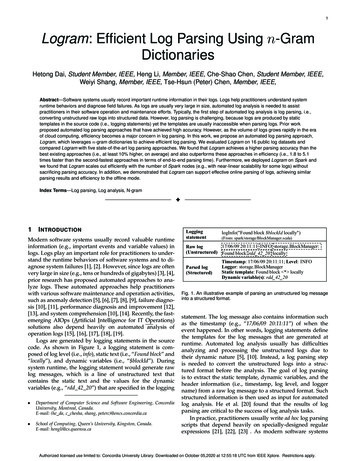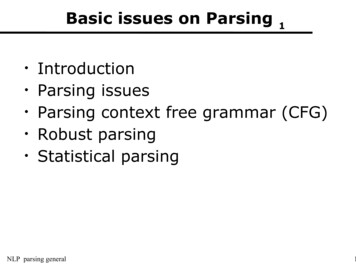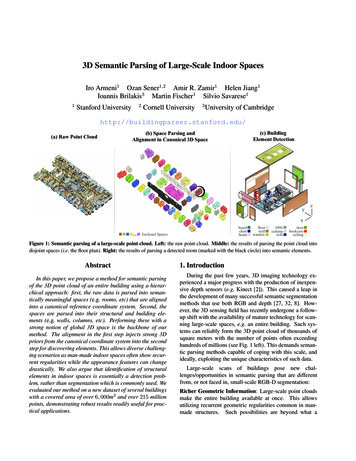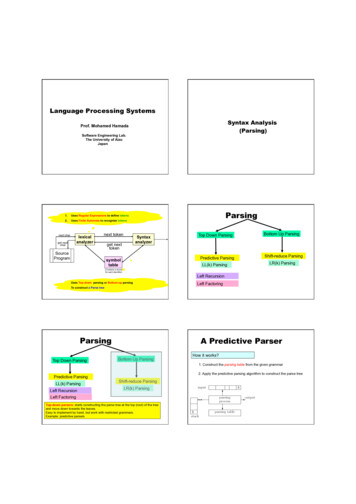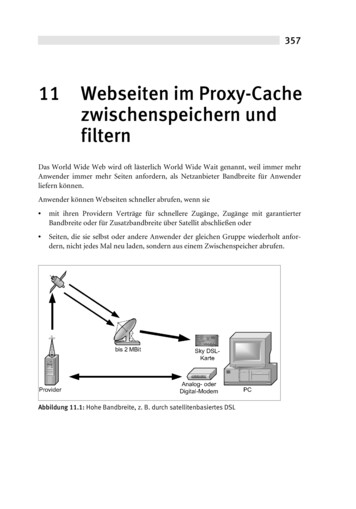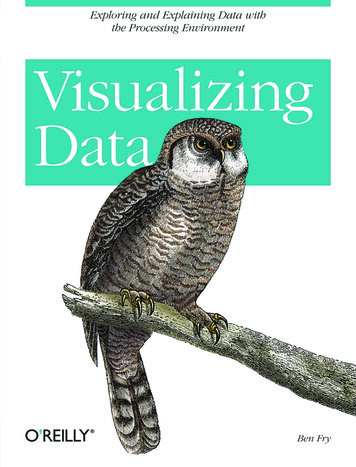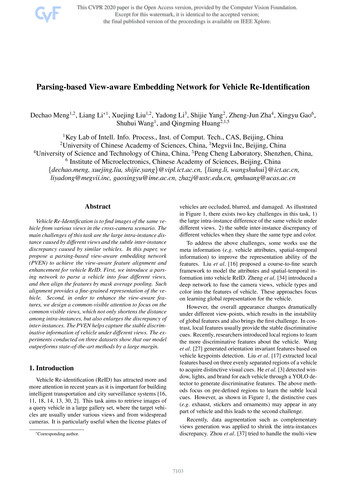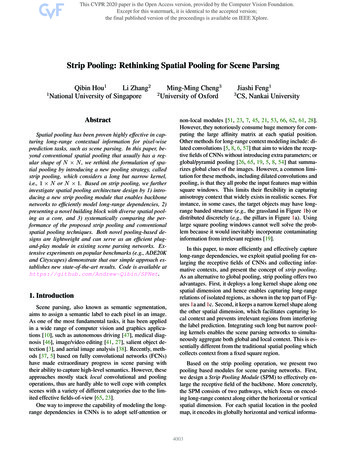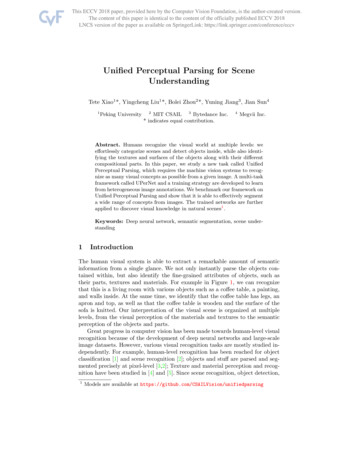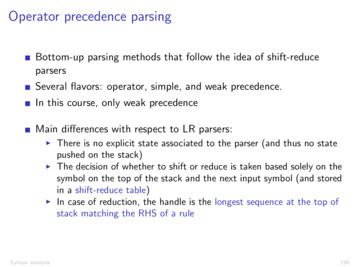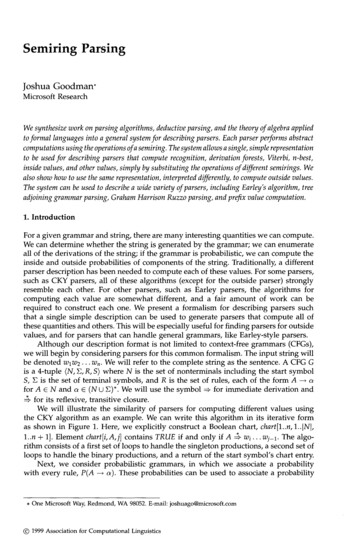
Transcription
Semiring ParsingJoshua Goodman*Microsoft ResearchWe synthesize work on parsing algorithms, deductive parsing, and the theory of algebra appliedto formal languages into a general system for describing parsers. Each parser performs abstractcomputations using the operations of a semiring. The system allows a single, simple representationto be used for describing parsers that compute recognition, derivation forests, Viterbi, n-best,inside values, and other values, simply by substituting the operations of different semirings. Wealso show how to use the same representation, interpreted differently, to compute outside values.The system can be used to describe a wide variety of parsers, including Earley's algorithm, treeadjoining grammar parsing, Graham Harrison Ruzzo parsing, and prefix value computation.1. IntroductionFor a given grammar and string, there are many interesting quantities we can compute.We can determine whether the string is generated by the grammar; we can enumerateall of the derivations of the string; if the grammar is probabilistic, we can compute theinside and outside probabilities of components of the string. Traditionally, a differentparser description has been needed to compute each of these values. For some parsers,such as CKY parsers, all of these algorithms (except for the outside parser) stronglyresemble each other. For other parsers, such as Earley parsers, the algorithms forcomputing each value are somewhat different, and a fair amount of work can berequired to construct each one. We present a formalism for describing parsers suchthat a single simple description can be used to generate parsers that compute all ofthese quantities and others. This will be especially useful for finding parsers for outsidevalues, and for parsers that can handle general grammars, like Earley-style parsers.Although our description format is not limited to context-free grammars (CFGs),we will begin by considering parsers for this common formalism. The input string willbe denoted wlw2. Wn. We will refer to the complete string as the sentence. A CFG Gis a 4-tuple (N, , R, S) where N is the set of nonterminals including the start symbolS, is the set of terminal symbols, and R is the set of rules, each of the form A --* afor A c N and a E (N U )*. We will use the symbol for immediate derivation andfor its reflexive, transitive closure.We will illustrate the similarity of parsers for computing different values usingthe CKY algorithm as an example. We can write this algorithm in its iterative formas shown in Figure 1. Here, we explicitly construct a Boolean chart, chart[1.n, 1.IN I,1.n 1]. Element chart[i,A,j] contains TRUE if and only if A G wi. wj-1. The algorithm consists of a first set of loops to handle the singleton productions, a second set ofloops to handle the binary productions, and a return of the start symbol's chart entry.Next, we consider probabilistic grammars, in which we associate a probabilitywith every rule, P(A --* a). These probabilities can be used to associate a probability* One Microsoft Way, Redmond, WA 98052. E-mail: joshuago@microsoft.comQ 1999 Association for Computational Linguistics
Computational LinguisticsVolume 25, Number 4boolean chart[1.n, 1.IN I, 1.n 1] : FALSE;for s : 1 to n/* start position */for each rule A - ws c Rchart[s, A, s l ] : TRUE;for l : 2 to n / * length, shortest to longest */for s : 1 to n-l 1/*startposition */for t : 1 to / - 1/* split length */for each rule A - B C R/* extra TRUE for expository purposes */chart[s, A, s.l.l] : chart[s, A, s l] V(chart[s, B, s t] A chart[s t, C, s l] A TRUE);r e t u r n chart[l, S, n 1];Figure 1CKY recognition algorithm.float chart[1.n, 1.IN[, 1.n 1] : 0;for s : I to n/* start position */for each rule A -- ws E Rchart[s, A, s l ] : P ( A -- ws);for / : 2 to n / * length, shortest to longest */for s : I to n - l l /* start position */for t : 1 to 1- 1/* split length */for each rule A - B C c Rchart[s, A, s l] : chart[s, A, s l] (chart[s, B, s t] x chart[s t, C, s l] x P ( A - BC));return chart[l, S, n 1];Figure 2CKY inside algorithm.with a particular derivation, equal to the p r o d u c t of the rule probabilities used in thederivation, or to associate a probability with a set of derivations, A wi. wj-1 equalto the s u m of the probabilities of the individual derivations. We call this latter probability the inside probability of i,A,j. We can rewrite the CKY algorithm to c o m p u t ethe inside probabilities, as s h o w n in Figure 2 (Baker 1979; Lari and Young 1990).Notice h o w similar the inside algorithm is to the recognition algorithm: essentially,all that has been done is to substitute for V, x for A, and P(A ws) and P(A BC)for TRUE. For m a n y parsing algorithms, this, or a similarly simple modification, is allthat is n e e d e d to create a probabilistic version of the algorithm. On the other hand, asimple substitution is not always sufficient. To give a trivial example, if in the CKYrecognition algorithm we had writtenchart[s,A,s l] : chart[s,A,s l] V chart[s,B,s t] A chart[s t,C,s l];instead of the less naturalchart[s, A, s l] : chart[s,A, s,l,l] V chart[s, B, s t] A chart[s t, C, s-t-l] A TRUE;larger changes w o u l d be necessary to create the inside algorithm.Besides recognition, four other quantities are c o m m o n l y c o m p u t e d b y parsingalgorithms: derivation forests, Viterbi scores, n u m b e r of parses, and outside probabilities. The first quantity, a derivation forest, is a data structure that allows one to574
GoodmanSemiring Parsingefficiently compute the set of legal derivations of the input string. The derivation forest is typically found by modifying the recognition algorithm to keep track of "backpointers" for each cell of how it was produced. The second quantity often computedis the Viterbi score, the probability of the most probable derivation of the sentence.This can typically be computed by substituting x for A and max for V. Less commonlycomputed is the total number of parses of the sentence, which, like the inside values,can be computed using multiplication and addition; unlike for the inside values, theprobabilities of the rules are not multiplied into the scores. There is one last commonlycomputed quantity, the outside probabilities, which we will describe later, in Section 4.One of the key points of this paper is that all five of these commonly computed quantities can be described as elements of complete semirings (Kuich 1997).The relationship between grammars and semirings was discovered by Chomsky andSchiitzenberger (1963), and for parsing with the CKY algorithm, dates back to Teitelbaum (1973). A complete semiring is a set of values over which a multiplicativeoperator and a commutative additive operator have been defined, and for which infinite summations are defined. For parsing algorithms satisfying certain conditions, themultiplicative and additive operations of any complete semiring can be used in placeof A and V, and correct values will be returned. We will give a simple normal formfor describing parsers, then precisely define complete semirings, and the conditionsfor correctness.We now describe our normal form for parsers, which is very similar to that usedby Shieber, Schabes, and Pereira (1995) and by Sikkel (1993). This work can be thoughtof as a generalization from their work in the Boolean semiring to semirings in general.In most parsers, there is at least one chart of some form. In our normal form, wewill use a corresponding, equivalent concept, items. Rather than, for instance, a chartelement chart[i,A,j], we will use an item [i,A,j]. Furthermore, rather than use explicit,procedural descriptions, such aschart[s,A,s l] : chart[s,A,s l] V chart[s,B,s t] A chart[s t,C,s l] A TRUEwe will use inference rules such asR(A BC)[i,B,k][i,A,j][k,C,j]The meaning of an inference rule is that if the top line is all true, then we can concludethe bottom line. For instance, this example inference rule can be read as saying that ifA BC and B G w i . . . Wk-1 and C w k . . . wj-1, then A G w l . . . Wj l.The general form for an inference rule will beA1 " . AkBwhere if the conditions A1 . Ak are all true, then we infer that B is also true. The Aican be either items, or (in an extension of the usual convention for inference rules)rules, such as R(A BC). We write R(A ---* BC) rather than A -- BC to indicate thatwe could be interested in a value associated with the rule, such as the probability ofthe rule if we were computing inside probabilities. If a n Ai is in the form R(.), wecall it a rule. All of the Ai must be rules or items; when we wish to refer to both rulesand items, we use the word terms.We now give an example of an item-based description, and its semantics. Figure 3gives a description of a CKY-style parser. For this example, we will use the inside575
Computational LinguisticsVolume 25, Number 4Item form:[i, A, j]Goal:[1, S, n 1]Rules:R(A - wi){i,A,i l]R(A -- BC)[i, B, k][i, A, j]Unary[k, C, j]BinaryFigure 3Item-based description of a CKY parser.semiring, whose additive operator is addition and whose multiplicative operator ismultiplication. We use the input string xxx to the following grammar:SX XX--* X XX--* x1.00.20.8(1)Our first step is to use the unary rule,R(Awi)[i,A,i l]The effect of the unary rule will exactly parallel the first set of loops in the CKY insidealgorithm. We will instantiate the free variables of the u n a r y rule in every possibleway. For instance, we instantiate the free variable i with the value 1, and the freevariable A with the nonterminal X. Since wl x, the instantiated rule is thenR(xx)[1,X,2]Because the value of the top line of the instantiated unary rule, R(X ---, x), has value0.8, we deduce that the bottom line, [1,X, 2], has value 0.8. We instantiate the rule intwo other ways, and compute the following chart values:[1,X,2] 0.8[2,X,3] 0.8[3,X,4] 0.8Next, we will use the binary rule,R(A --* BC)[i, B, k][k, C,j][i,A,j]The effect of the binary rule will parallel the second set of loops for the CKY insidealgorithm. Consider the instantiation i 1, k -- 2, j 3, A -- X, B X, C -- X,R(X XX)[1, X, 2][1,X,3]576[2, X, 3]
GoodmanSemiring ParsingWe use the multiplicative operator of the semiring of interest to multiply together thevalues of the top line, deducing that [1, X, 3] 0.2 x 0.8 x 0.8 0.128. Similarly,[1,X,3] 0.128[2,X,4] 0.128[1,S,3]--0.64[2,S,4] 0.64There are two more ways to instantiate the conditions of the binary rule:R(S -- X X )[1, X, 2][1, S, 4][2, X,4]R(S -- X X )[1,X,3][1, S, 4][3, X,4]The first has the value 1 x 0.8 x 0.128 0.1024, and the second also has the value0.1024. W h e n there is more than one w a y to derive a value for an item, we use theadditive operator of the semiring to sum them up. Thus, [1, S, 4] -- 0.2048. Since [1, S, 4]is the goal item for the CKY parser, we k n o w that the inside value for xxx is 0.2048.The goal item exactly parallels the return statement of the CKY inside algorithm.1.1 Earley ParsingM a n y parsers are m u c h more complicated than the CKY parser, and w e will need toexpand our notation a bit to describe them. Earley's algorithm (Earley 1970) exhibitsmost of the complexities we wish to discuss. Earley's algorithm is often described asa bottom-up parser with t o p - d o w n filtering. In a probabilistic framework, the bottomu p sections c o m p u t e probabilities, while the t o p - d o w n filtering nonprobabilisticallyremoves items that cannot be derived. To capture these differences, we e x p a n d ournotation for deduction rules, to the following:al""akBC1.CjC1 " " Cj are side conditions, interpreted nonprobabilistically, while A1 .-- Ak are m a i nconditions with values in whichever semiring we are using. 1 While the values of allmain conditions are multiplied together to yield the value for the item u n d e r the line,the side conditions are interpreted in a Boolean manner: if all of them are nonzero,the rule can be used, but if any of them are zero, it cannot be. Other than for checkingw h e t h e r they are zero or nonzero, their values are ignored.Figure 4 gives an item-based description of Earley's parser. We assume the additionof a distinguished nonterminal S' with a single rule S' -- S. An item of the form[i,A --, c ,J fl, j] asserts that A aft G w i . . . wj-lfl.1 The side conditions m a y d e p e n d on a n y purely local i n f o r m a t i o n - - t h e v a l u e s of A 1 . . . Ak, B, orC1 . Cj, as well as constant global functions, s u c h as R(X) 6 sin(Y) ( a s s u m i n g here X a n d Y arevariables in the A, B, C). The side conditions u s u a l l y cannot d e p e n d o n a n y contextual information,s u c h as the g r a n d f a t h e r of A1, w h i c h w o u l d n o t be well defined, since there m i g h t be m a n y derivationsof A1. Of course, one could encode the g r a n d f a t h e r of A1 as a variable in the item A1, a n d t h e n h a v e ad e p e n d e n c y on that variable. This w o u l d g u a r a n t e e that the context w a s u n i q u e a n d well defined.577
Computational LinguisticsVolume 25, Number 4Item form:[ i , A - a . fl, j]Goal:[1,s' S. ,n l]Rules:[1, S' - S, 1][i, A - a w j f l , j][i,A - a w j fl, j l ]R ( B -- "7) [i, A a Bfl, j][j,B -'7,j][i, A -- a Bfl, k l[k, B "7 , j][i, A - a B fl, j]InitializationScanningPredictionCompletionFigure 4Item-based description of Earley parser.The prediction rule includes a side condition, making it a good example. Therule is:R ( 7 B '.7 ,j])[ i , A a . Bfl, j] ,-- Through the prediction rule, Earley's algorithm guarantees that an item of the form ', B - '7,j] can only be produced if S Wl . . . w j l B 6 for some 6; this top-downfiltering leads to significantly more efficient parsing for some grammars than the CKYalgorithm. The prediction rule combines side and main conditions. The side condition, [i,A -- ce Bfl,j], provides the top-down filtering, ensuring that only items thatmight be used later by the completion rule can be predicted, while the main condition, R ( B -- "7), provides the probability of the relevant rule. The side conditionis interpreted in a Boolean fashion, while the main condition's actual probability isused.Unlike the CKY algorithm, Earley's algorithm can handle grammars with epsilon (e), unary, and n-ary branching rules. In some cases, this can significantly complicate parsing. For instance, given unary rules A -- B and B -- A, a cycle exists. This kind of cycle may allow an infinite number of different derivations, requiring an infinite summation to compute the inside probabilities. The ability ofitem-based parsers to handle these infinite loops with relative ease is a majorattraction.1.2 O v e r v i e wThis paper will simplify the development of new parsers in three important ways.First, it will simplify specification of parsers: the item-based description is simplerthan a procedural description. Second, it will make it easier to generalize parsersacross tasks: a single item-based description can be used to compute values for avariety of applications, simply by changing semirings. This will be especially advantageous for parsers that can handle loops resulting from rules like A -- A andcomputations resulting from productions, both of which typically lead to infinitestuns. In these cases, the procedure for computing an infinite sum differs from semi-578
GoodmanSemiring Parsingring to semiring, and the fact that we can specify that a parser computes an infinite s u m separately from its m e t h o d of computing that sum will be v e r y helpful. The third use of these techniques is for c o m p u t i n g outside probabilities, values related to the inside probabilities that we will define later. Unlike the otherquantities we wish to compute, outside probabilities cannot be c o m p u t e d b y simply substituting a different semiring into either an iterative or item-based description. Instead, we will show h o w to c o m p u t e the outside probabilities using a modified interpreter of the same item-based description used for c o m p u t i n g the othervalues.In the next section, we describe the basics of semiring parsing. In Section 3, wederive formulas for c o m p u t i n g most of the values in semiring parsers, except outside values, and then in Section 4, show h o w to c o m p u t e outside values as well. InSection 5, we give an algorithm for interpreting an item-based description, followedin Section 6 b y examples of using semiring parsers to solve a variety of problems.Section 7 discusses previous work, and Section 8 concludes the paper.2. Semiring ParsingIn this section we first describe the inputs to a semiring parser: a semiring, an itembased description, and a grammar. Next, we give the conditions u n d e r which a semiring parser gives correct results. At the end of this section we discuss three especiallycomplicated and interesting semirings.2.1 SemiringIn this subsection, we define and discuss semirings (see Kuich [1997] for an introduction). A semiring has two operations, and , that intuitively have most (butnot necessarily all) of the properties of the conventional and x operations on thepositive integers. In particular, we require the following properties: is associativeand commutative; is associative and distributes over G. If @ is commutative, wewill say that the semiring is commutative. We assume an additive identity element,which we write as 0, and a multiplicative identity element, which we write as 1. Bothaddition and multiplication can be defined over finite sets of elements; if the set isempty, then the value is the respective identity element, 0 or 1. We also assume thatx @ 0 0 x 0 for all x. In other words, a semiring is just like a ring, except that theadditive operator need not have an inverse. We will write /A, , , 0,1 / to indicate asemiring over the set A with additive operator , multiplicative operator @, additiveidentity 0, and multiplicative identity 1.For parsers with loops, i.e., those in which an item can be used to derive itself,we will also require that sums of an infinite n u m b e r of elements be well defined. Inparticular, we will require that the semirings be complete (Kuich 1997, 611). This meansthat sums of an infinite n u m b e r of elements should be associative and commutative,just like finite sums, and that multiplication should distribute over infinite sums, justas it does over finite ones. All of the semirings we will deal with in this p a p e r arecomplete. 2All of the semirings we discuss here are also w-continuous. Intuitively, this meansthat if any partial sum of an infinite sequence is less than or equal to some value,2 Completeness is a somewhat stronger condition than we really need; we could, instead, require thatlimits be appropriately defined for those infinite sums that occur while parsing, but this weakercondition is more complicated to describe precisely.579
Computational LinguisticsVolume 25, Number 4booleaninsideViterbicountingderivation forestViterbi-derivation({TRUE, FALSE }, V, A, FALSE, TRUE)ViiVitViterbi-n-best({topn(X)IXE , x, o, 1 (II , max, x, O, 1)( I , , ,0, 1){0} (l 1 x 2E, max, x, (0,0 , (1, {( } 2 x }, max, x , 0,Vit-nrecognitionstring probabilityprob. of best derivationnumber of derivationsset of derivationsbest derivationbest n derivations{0,{ } } Figure 5Semirings used: {A,@, , 0,1/.then the infinite sum is also less than or equal to that value. 3 This important propertymakes it easy to compute, or at least approximate, infinite sums.There will be several especially useful semirings in this paper, which are definedin Figure 5. We will write P to indicate the set of real numbers from a to b inclusive,with similar notation for the natural numbers, N. We will write E to indicate theset of all derivations in some canonical form, and 2n to indicate the set of all setsof derivations in canonical form. There are three derivation semirings: the derivationforest semiring, the Viterbi-derivation semiring, and the Viterbi-n-best semiring. Theoperators used in the derivation semirings (., max, x, max, and x ) will be describedVit Vit Vit-nVit-nlater, in Section 2.5.The inside semiring includes all nonnegative real numbers, to be closed underaddition, and includes infinity to be closed under infinite sums, while the Viterbisemiring contains only numbers up to 1, since under max this still leads to closure.The three derivation forest semirings can be used to find especially important values: the derivation forest semiring computes all derivations of a sentence; the Viterbiderivation semiring computes the most probable derivation; and the Viterbi-n-bestsemiring computes the n most probable derivations. A derivation is simply a listof rules from the grammar. From a derivation, a parse tree can be derived, so thederivation forest semiring is analogous to conventional parse forests. Unlike the othersemirings, all three of these semirings are noncommutative. The additive operationof these semirings is essentially union or maximum, while the multiplicative operation is essentially concatenation. These semirings are described in more detail inSection 2.5.2.2 Item-based DescriptionA semiring parser requires an item-based description of the parsing algorithm, in theform given earlier. So far, we have skipped one important detail of semiring parsing. Ina simple recognition system, as used in deduction systems, all that matters is whetheran item can be deduced or not. Thus, in these simple systems, the order of processingitems is relatively unimportant, as long as some simple constraints are met. On theother hand, for a semiring such as the inside semiring, there are important orderingconstraints: we cannot compute the inside value of an item until the inside values of3 To be more precise, all semirings we discuss here are naturally ordered, m e a n i n g that w e can define apartial ordering, U, such that x Uy if and only if there exists z such that x @ z ----y. We call a naturallyordered complete semiring w-continuous (Kuich 1997, 612) if for any sequence Xl, x2. . . . and for anyconstant y, if for all n, ( o i n xi U y, then ( i xi U y.580
GoodmanSemiring Parsingall of its children have been computed.Thus, we need to impose an ordering on the items, in such a w a y that no itemprecedes any item on which it depends. We will assign each item x to a "bucket"B, writing bucket(x) B and saying that item x is associated with B. We order thebuckets in such a w a y that if item y d e p e n d s on item x, then bucket(x) bucket(y). Forsome pairs of items, it m a y be that both depend, directly or indirectly, on each other;we associate these items with special "looping" buckets, whose values m a y requireinfinite sums to compute. We will also call a bucket looping if an item associated withit depends on itself.One w a y to achieve a bucketing with the required ordering constraints (suggestedb y Fernando Pereira) is to create a graph of the dependencies, with a node for eachitem, and an edge from each item x to each item b that d e p e n d s on it. We thenseparate the graph into its strongly connected c o m p o n e n t s (maximal sets of nodes allreachable from each other), and p e r f o r m a topological sort. Items forming singletonstrongly connected components are associated with their o w n buckets; items formingnonsingleton strongly connected c o m p o n e n t s are associated with the same loopingbucket. See also Section 5.Later, w h e n w e discuss algorithms for interpreting an item-based description, w ewill need another concept. Of all the items associated with a bucket B, we will beable to find derivations for only a subset. If we can derive an item x associated withbucket B, we write x E B, and say that item x is in bucket B. For example, the goalitem of a parser will almost always be associated with the last bucket; if the sentenceis grammatical, the goal item will be in the last bucket, and if it is not grammatical, itwill not be.It will be useful to assume that there is a single, variable-free goal item, and thatthis goal item does not occur as a condition for any rules. We could always add an e w goal item oal] and a rule[old-goal] oal] where [old-goal] is the goal in the originaldescription.2.3 The GrammarA semiring parser also requires a g r a m m a r as input. We will need a list of rules in thegrammar, and a function, R(rule), that gives the value for each rule in the grammar.This latter function will be semiring-specific. For instance, for c o m p u t i n g the insideand Viterbi probabilities, the value of a g r a m m a r rule is just the conditional probabilityof that rule, or 0 if it is not in the grammar. For the Boolean semiring, the value isTRUE if the rule is in the grammar, FALSE otherwise. R(rule) replaces the set of rulesR of a conventional g r a m m a r description; a rule is in the g r a m m a r if R(rule) O.2.4 Conditions for Correct ProcessingWe will say that a semiring parser works correctly if, for any grammar, input, andsemiring, the value of the input according to the g r a m m a r equals the value of the inputusing the parser. In this subsection, w e will define the value of an input accordingto the grammar, define the value of an input using the parser, and give a sufficientcondition for a semiring parser to w o r k correctly. From this point onwards, unless wespecifically mention otherwise, we will assume that some fixed semiring, item-baseddescription, and g r a m m a r have been given, without specifically mentioning whichones.2.4.1 Value According to Grammar. Consider a derivation E, consisting of g r a m m a rrules el, e2. . . . . era. We define the value of the derivation according to the g r a m m a r to581
Computational LinguisticsVolume 25, Number 4be simply the p r o d u c t (in the semiring) of the values of the rules used in E:mVG(E) : @ R(ei)i:1Then we can define the value of a sentence that can be derived using g r a m m a r derivations E 1, E2. . . . . E k to be:kv (D v (EJ)j 1where k is potentially infinite. In other words, the value of the sentence according tothe g r a m m a r is the s u m of the values of all derivations. We will assume that in eachg r a m m a r formalism there is some w a y to define derivations uniquely; for instance, inCFGs, one w a y w o u l d be using left-most derivations. For simplicity, w e will simplyrefer to derivations, rather than, for example, left-most derivations, since w e are neverinterested in n o n u n i q u e derivations.A short example will help clarify. We consider the following grammar:sAA AA-- A A-- aa(S- AA)(2)a(A- AA)R(A- a)and the input string aaa. There are two g r a m m a r derivations, the first of which S-- AA,,A-- AAis A m ,, --A--- a.A--- a--A--- aA A A a A A aaA aaa, which has value R(S -- A A ) R ( A -- A A ) R ( A -- a) R ( A -- a) R ( A -- a). Notice that the rules in the value arethe same rules in the same order as in the derivation. The other g r a m m a r deriva S--*AA-- A--*ation is A-- AA A - - * aA--*a.4.4 aA a A A aaA aaa, which has value R ( S -- A A ) R ( A -- a) R ( A - A A ) R ( A -- a) R ( A ---* a). The value of the sentence is the s u m of thevalues of the two derivations,[R(s -- AA) R(A - AA) 0 a ( A -- a) R(A -- ) R(A -- a)][a(S -- AA) O R(A -- a) R(A -- AA) R(A -* a) R(A -- )] 2.4.2 I t e m D e r i v a t i o n s . Next, we define item derivations, i.e., derivations using theitem-based description of the parser. We define item derivation in such a w a y thatfor a correct parser description, there is exactly one item derivation for each g r a m m a rderivation. The value of a sentence using the parser is the sum of the value of allitem derivations of the goal item. Just as with g r a m m a r derivations, individual itemderivations are finite, but there m a y be infinitely m a n y item or g r a m m a r derivationsof a sentence.We say that Cl. cj is an instantiation of d e d u c t i o n rule A1 .B. Ak C 1 . . . Cjw h e n e v e r the first expression is a variable-free instance of the second; that is, the firstexpression is the result of consistently substituting constant terms for each variable inthe second. Now, we can define an i t e m d e r i v a t i o n tree. Intuitively, an item derivation582
GoodmanSemiring Parsing----A.- a--A.-- a : A A: A A A:: a A A a a A : a a asS-- AA----A- AA------A-.- aG r a m m a r DerivationR(S -- AA)R(A - a)a)G r a m m a r Derivation Tree[1, S, 4]R( S,4]-- A R (A -- a)R(A,3]IR(A-- a)IR(A a)I t e m Derivation ] t e eR(S - AA) R(A AA) R(A -- a) R(A a) R(A - a)Derivation ValueFigure 6Grammar derivation, grammar derivation tree, item derivation tree, and derivation value.tree for x just gives a w a y of d e d u c i n g x f r o m the g r a m m a r rules. We define anitem derivation tree recursively. The base case is rules of the g r a m m a r : (r / is an itemderivation tree, w h e r e r is a rule of the g r a m m a r . Also, if Dal . . . . . Dak, Dcl. . . . . Dcj arederivation trees h e a d e d b y al. ak, Cl. Cj respectively, and if c l . . .cj is theinstantiation of a d e d u c t i o n rule, then (b: D 1. . . . . D k/ is also a derivation tree. Noticethat the De1 . Dq do not occur in this tree: they are side conditions, a n d a l t h o u g h theirexistence is required to p r o v e that cl . cj could be derived, they do not contribute tothe value of the tree. We will write a l . .b. ak to indicate that there is an item derivation tree of the f o r m (b: Da,. . . . . Dakl. As m e n t i o n e d in Section 2.2, w e will writex E B if bucket(x) B a n d there is an item derivation tree for x.We can continue the e x a m p l e of parsing aaa, n o w u
adjoining grammar parsing, Graham Harrison Ruzzo parsing, and prefix value computation. 1. Introduction For a given grammar and string, there are many interesting quantities we can compute. We can determine whether the string is generated by the grammar; we can enumerate all of the derivations of the string; if the grammar is probabilistic, we .
